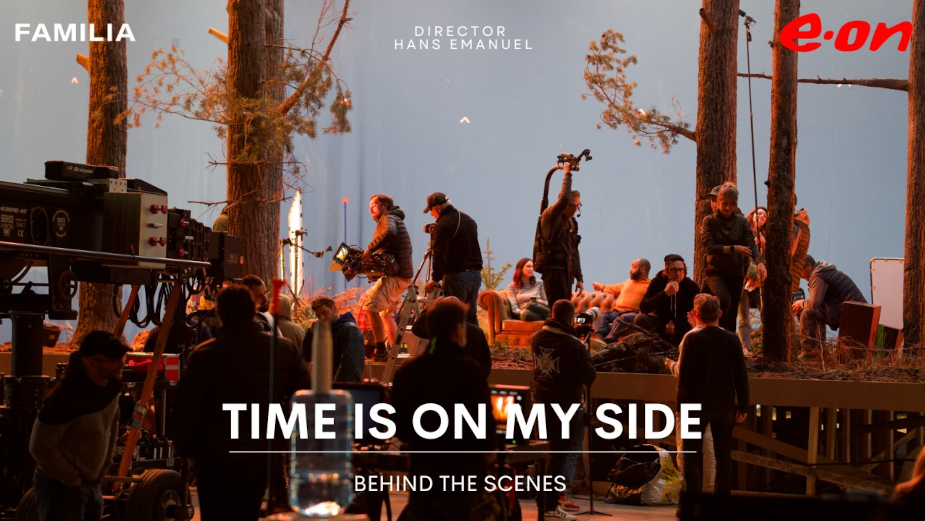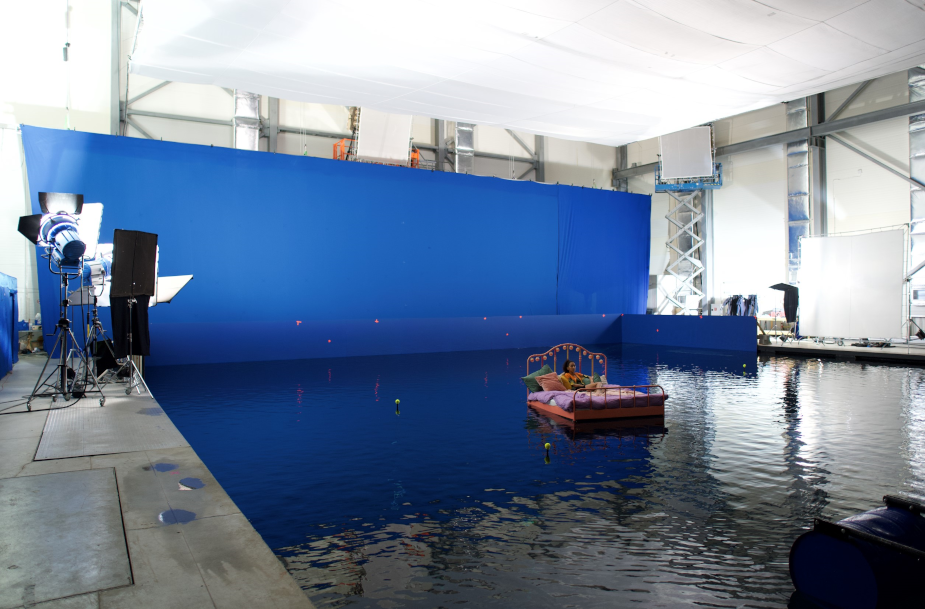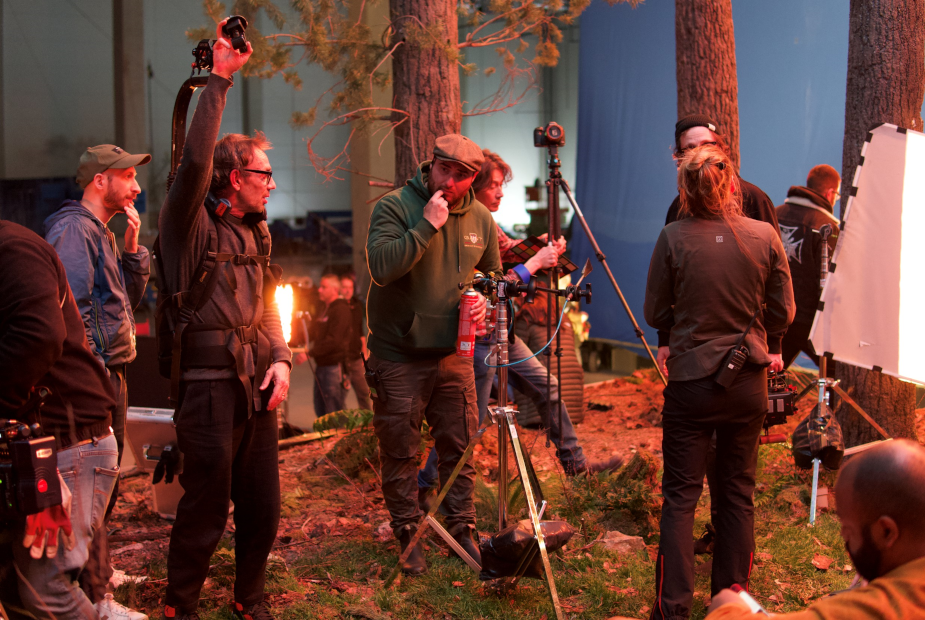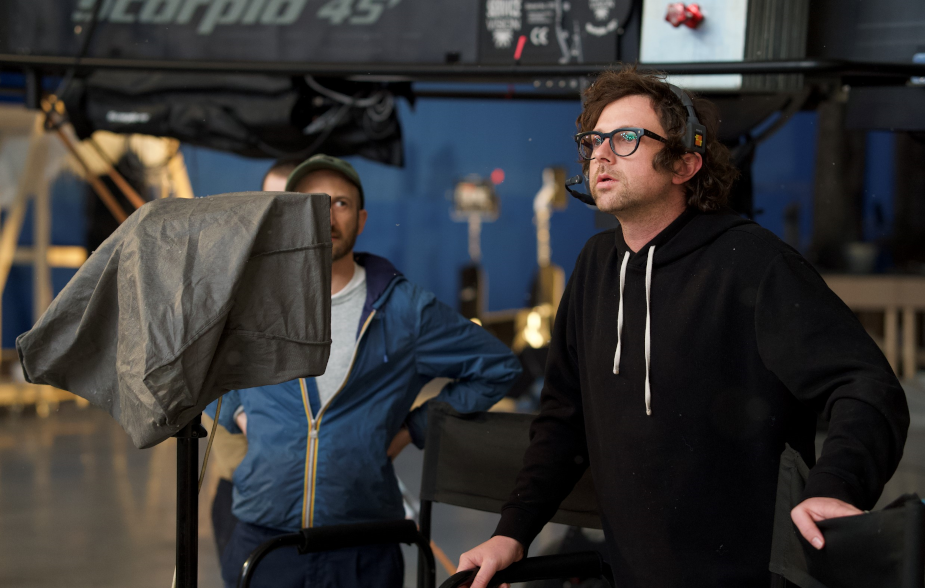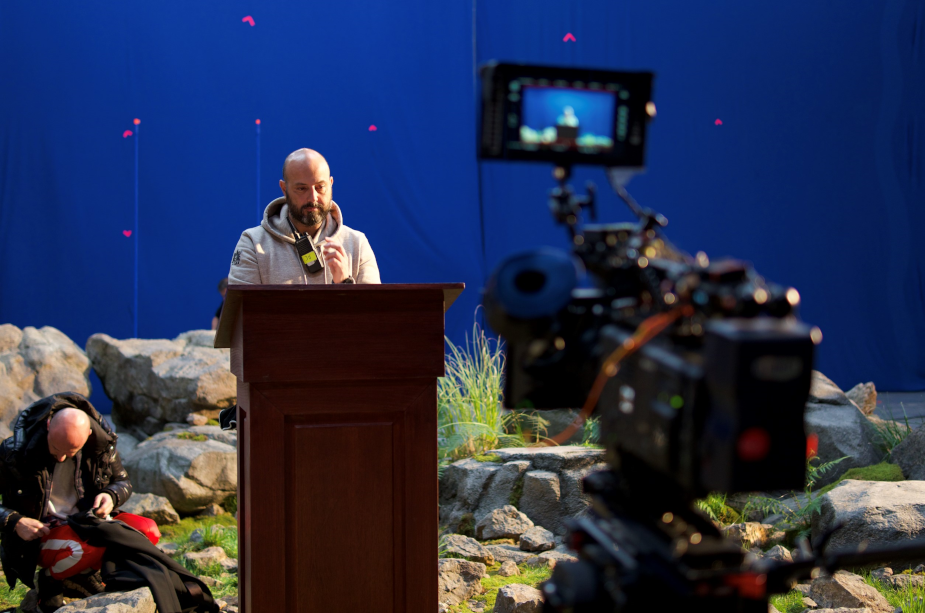Hans Emanuel and the Tale of Depleting Time
-

-
Hans is known for work that harbours an epic cinematic presence; he’s also renowned as being one of the most collaborative directors around. Having directed in the industry for over 10 years now, Hans still refers to the set as his ‘playground’. However, the E.ON, ‘It’s Time’ campaign would become a different kind of playground to any he’d experienced before. Spanning two counties and completed within a tight two-month timeframe, the film captures the essence of Hans’ talent for blending visuals with narrative.
Within all but 60 seconds, the message could not be clearer – we are running out of time to fix the mess we’ve made. Scenes rush from cracking icecaps, to flooded streets, tornados tower and twirl, whilst forests burn and flames rise. All this, whilst the individuals sit unawares, staring at phones, heads buried in tables, idly singing the ironic lines from Irma Thomas’ ‘Time Is On My Side’. Each line feels more haunting than the last, as the situations on screen become increasingly dire. In this interview, we hear from Hans about how the team managed to pull off the project, how he achieved some truly remarkable visuals and the lasting imprint that has been left on him beyond this.
-
LBB> Hans, the spot is fantastic; tell us about the initial stages when you first encountered the brief
-
Hans> Let me tell you, it was an exhilarating journey right from the start. Back in April, we received the brief, and the project took off at warp speed. The moment I laid eyes on the concept, I was blown away. It was like reading a script for an epic blockbuster. The scale of the story was massive, and we were all buzzing with excitement, thinking, “How on earth are we going to bring this to life?”
We faced the challenge of creating visuals that were not only visually stunning but also captured the essence of the characters. Balancing the doomsday, epic destruction elements with the lighthearted musical moments and scenes of our politicians twirling in a tornado required careful consideration. It was all about finding that perfect equilibrium.
To make sure our message resonated with viewers, we delved into research to gauge their receptiveness and preferences. We discovered that people gravitate towards content with a comedic twist, so we incorporated elements of humour. However, our ultimate goal was to convey a sense of hope. We wanted to show that despite the challenges we face, there is a solution, and we still have time to turn things around as a society.
It was an incredible journey filled with creativity, collaboration, and a lot of passion. I’m proud of the end result and how we managed to strike the right balance between awe-inspiring visuals and an uplifting message of hope.
-
LBB> What can you tell us about the main messaging that you were trying to portray?
-
Hans> Well, the messaging we aimed to convey in this project was nothing short of powerful. We wanted to ignite a feeling of frustration, that moment when you realise we’re all so immersed in our screens that we’ve lost touch with the world around us. It was crucial for us to showcase the stark contrast between the chaos of ravaging landscapes and the mundane moments of family life.
The sense of frustration was symbolised beautifully through a couch potato – someone more concerned with their screens than the reality unfolding right in front of them. And then we have the teenager, representing the next generation, engrossed in social media. It was a wake-up call, urging viewers to recognise the importance of paying attention and being present.
With a film all about sustainability, it was our biggest challenge to find production and creative solutions to executing the scenes in a sustainable way. This went beyond just the set builds, and this way of thinking became a way of life. From solar powered studios, to our low intervention wine choices at our wrap meal.
We poured our hearts and souls into this project, and we hope that it sparks a fire within viewers, prompting them to reevaluate their own relationship with technology and the world around them. It’s a call to action, urging us all to open our eyes and make a change before it’s too late.
-

-
LBB> Watching the campaign, it appears quite technically challenging. Can you tell us what this involved?
-
Hans> Oh, few know how technically stimulating this campaign was. It demanded an immense amount of preparation from myself and my team, unlike anything I’ve experienced before. Picture this: starting with an empty studio space and bringing to life an entire world straight from our imagination. It was like creating something out of thin air.
We invested significant time in meticulously planning the shots, and the process was absolutely fascinating. Collaborating closely with the agency, I almost sketched out the footage, visualising each scene. Then, working with the editor, we dove into the editing process. This allowed us to fine-tune the timing, ensuring the message hit home, while maintaining visually impactful moments without becoming overly dynamic. Believe it or not, we went through about 12 to 13 versions of this careful preparation. We transformed those frames into pre-visualisations, integrating them into the edit, and creating a live vision of what the film would ultimately look like.
The real challenge was leaving no stone unturned. We racked our brains, obsessing over every single detail long before the actual filming took place. We must have scrutinised it a million times, ensuring that every shot was pre-designed to its fullest potential. And let’s not forget the incredible work done by the post-production house in bringing each scene to life with the perfect looks.
It was a journey that pushed our technical boundaries and rewarded us with a campaign that not only met, but exceeded our wildest expectations.
-

-
LBB> You’ve previously described yourself as taking a cinematic approach to everything that you work on. That’s quite evident in this piece. What do you take into consideration to achieve this kind of aesthetic?
-
Hans> I think one of the things with post heavy jobs is that sometimes you can get lost within the post production. Sometimes you can lose that sense of humanity. Having those close ups of our talent allowed for more intimate moments that helped to portray the humanity and emotion. That, mixed together in these big, wide, epic shots and they all fall together to make that one piece, ensuring it doesn’t become purely post-production oriented. When you strike that balance it becomes something that’s narrative and intimate but also cinematic. The cinematic side of things will come from how you shoot it, with the depth of field, the foreground, having those textures with the objects on the ground. It’s in playing with all of these elements that you’re able to achieve such a result.
-
LBB> Obviously, the focus here was on the climate crisis and what E.ON is doing to tackle it. From a production standpoint, what steps were taken to ensure the campaign was sustainable?
-
Hans> I have to give credit to Ciaran, David, Toby and the other members of production who came up with a very big plan. The film was shot between the UK and Bulgaria. The studio we used in Bulgaria had a solar panelled roof, so everything we were using on the shoot was renewable energy. Then of course there were the smaller things, like using reusable water bottles to ensure nothing was being thrown away. In the production it was all recycled paper as opposed to new. The team tried to encourage as many electric vehicles as possible. They were light on wardrobe and used sustainable brands. Everything we used on the shoot was recycled after; it’s a different reality on a lot of shoots where everything just gets dumped. The intention on the production side of things was to make it as sensible as possible whilst having the least carbon impact.
But yeah, sustainability was a massive part of this job. You know, we felt very conscious that we couldn’t create a message and then actually not live up to it ourselves. We had to put our money where our mouth was. In trying to make these improvements we ended up finding new ways of working, which now we can bring into other productions going forward as well.
-

-
LBB> How easy was it to align the visuals and the message with the original lyrics of the track?
-
Hans> It was quite a challenge to be honest, but a worthwhile one. We worked closely with the editor on set to ensure that the visuals complemented the lyrics. There was very little room for improvisation; everything was intricately planned during the pre-production stage. We thought long and hard about the precise moments where each word would land, creating a synchronicity between the song and the message we wanted to convey.
The agency deserves kudos for their brilliant choice of the song. The way they played with the word ‘time’ and the concept of its fleeting nature was incredibly clever. It’s a tune that immediately grabs hold of you, and you can’t help but find yourself humming along. It’s not only a brilliant interplay between lyrics and messaging but also a catchy melody that effortlessly captures people’s attention.
In the end, the fusion of visuals and lyrics resulted in a powerful synergy that we hope will stick with audiences. It was a challenging process, but the outcome was something that people can hopefully connect with on multiple levels.
-

-
LBB> What would you say has been your biggest takeaway from the whole experience?
-
Hans> Reflecting on the entire experience, my biggest takeaway has been the profound impact of the message itself. It was like a wake-up call, a jolt that shook me to my core. We often hear discussions about global warming and the ongoing battle between those who fight for change and those who oppose it. But there’s always a sense of detachment when we read about it on our smartphones.
This project, however, brought the harsh reality of our world into sharp focus. It peeled away the layers of complacency and made me confront the truth of where we currently stand. The concept struck a chord with me on a personal level, and it ignited a fire within me to be more conscious and proactive in every possible way.
It’s a commanding reminder that we can no longer afford to be passive observers; we must take responsibility for our actions and strive to make a positive impact. This experience has forever changed my perspective, and I’m committed to playing my part in creating a better future for our planet.
